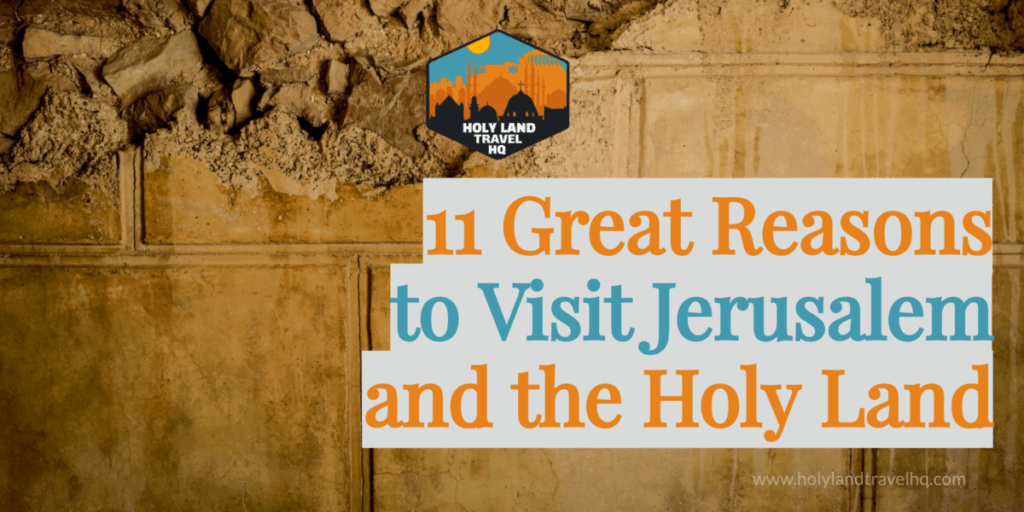
For some Christians, a Holy Land tour is a no brainer. You know you want to go and you have the funds to go. For others, the funds might not appear to be there and there isn’t enough information to make a commitment.
There are plenty of articles out there on why you should visit Jerusalem, or Israel, or the Holy Land. But many of the reasons aren’t much different than other travel destinations. The food is great and the sights are fantastic. But these don’t explain why Christians pilgrims go to Jerusalem.
So, let’s take a look at 11 reasons why you should visit Jerusalem and the Holy Land.
- Jerusalem and Israel are safe!
- The city where Christ sacrificed Himself on the cross is a real place.
- Visiting the Holy Land will give you a better sense of the stories in the Bible.
- To understand the Disciples as fishers of men, you have to get on the Sea of Galilee.
- You can see the complexities of modern and ancient geopolitics sitting on top of each other.
- You’ll connect with God and your faith in ways you can’t at home.
- A Holy Land tour is financially doable and worth it.
- The Dead Sea is the lowest place on Earth.
- Jerusalem is THE focal point for all 3 Abrahamic religions.
- Because it’s old.
- You can leave a prayer note in the Western Wall.
Note: All links are direct. All bible verses are linked to Biblegateway.com.
1. Jerusalem and Israel are safe!
Of all the places I’ve traveled to around the world, Israel is by far one of the safest. Even safer than some of America’s most prominent cities. Don’t get me wrong though, Israel does have its problems.
1) Terrorism is not as prominent as you’re told, but it does happen. Tourists buy things and there is a reluctance to upset that balance. Also, much of the Israeli-Palestinian conflict occurs in the margin. Meaning, it happens in ways outsiders don’t see or understand. It’s much more productive to poke at the Israeli Government when no one is looking in order to elicit a response. Whether it be violent or political, it can be argued that the response was unprovoked. However, if it happened in a tourist area surrounded by thousands of smart phones watching, media spin is much harder. Modern terrorism is extremely aware when it comes to the media.
2) A more probable threat to Christians actually comes from the Orthodox Jewish community. The threat is low though. It’s often unorganized, unplanned and normally directed towards Christians walking alone. The reasons usually surround land disputes. The threat typically manifests in the form of intimidation vice violence. Don’t back down though, this paper tiger easily retreats.
And
3) Your biggest issue will be petty crime and swindling. Language barriers and a traveler’s unfamiliarity with the environment are a thief’s weapons. These things are common around the world, even in your hometown.
Understanding the issues can help you navigate the threats better. For an in-depth guide on security in Israel, check out my post on the topic right here.
For travel safety tips and how to improve your security posture, check out my post on the topic right here.
2. The city where Christ sacrificed Himself on the cross is a real place.
In Hebrews 11:1, the author states, “faith is confidence in what we hope for and assurance about what we do not see.” As Christians, we have faith in God. We trust that the Word of God, the Bible, is inerrant. We don’t need proof to believe God exists. But that doesn’t mean there is no proof.
One of the things that Christianity ushered into history, besides Christ’s sacrifice, is science and reason. Early Christians could easily point to Calvary or the empty tomb and ask, “if it isn’t real then why that?”
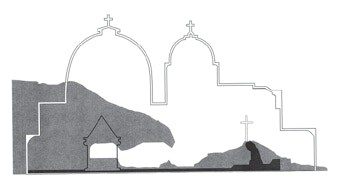
These first century Christians saw something happen and they passed that knowledge on. In my post about the Church of the Holy Sepulchre, I talk about this. Despite the Roman siege of Jerusalem in 70 CE and the renaming of the city, the Christian community remained.
In 135 BCE the Romans built a temple to the goddess Venus over what 1st century Christians knew was the tomb.
When Helena came to find the tomb in 326 BCE, the spot was marked. “Ya, it’s over there under that Temple,” someone might have said. When the temple was torn down a tomb was, in fact, there. And today we have the Church of the Holy Sepulchre.
There are tons of spots in Jerusalem and throughout Israel that line up with the Bible. Spots like Hezekiah’s tunnel, the Pools of Bethesda, the Lion’s Gate / East Gate, and the Southern Steps.
Seeing these sites puts you in the story. It makes everything you’ve read about, studied and imagined come alive. Which brings me to my next reason.
3. Visiting the Holy Land will give you a better sense of the stories in the Bible.
When you stand over the Valley of Elah and see how small it is, you’ll understand the battle David won. As Americans, our concept of landscape is often framed by places like the Grand Canyon, or the Rocky Mountains. Or Death Valley. We imagine vast landscapes as far as the eye can see.
Israel is small. The Valley of Elah is really small.

In 1 Samuel 17, we get a description of the two armies chanting at each other. And then they all watch David beat Goliath. When I was a kid, I figured that stuff was all semantics. Maybe the soldiers up front saw the dual. But there was no way everyone saw it.
When I stood over the Valley of Elah for the first time, I realized how up-close that battle was. It became real to me.
Israel is filled with spots like this. The Sorek Valley from Sampson and Delilah is another example.
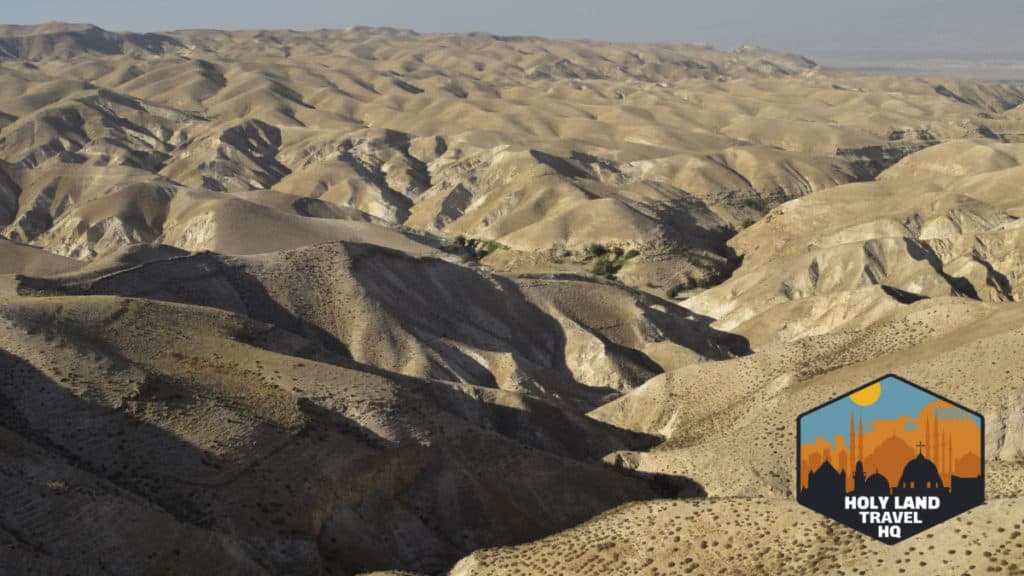
Or, the wilderness. The Judean Wilderness is probably the most captivating sight I saw on my first trip. It has been largely untouched and today pockets of nomads and sheepherders live there. A stop at any of the lookouts will give you an idea of how dangerous it was and probably still is.
The Judean wilderness is miles upon miles of rolling hills where one could easily get lost and die of heat exhaustion. Or get eaten by wildlife. It makes Jesus’s 40 days in the wilderness sound much harsher than say, 40 days in Yosemite.
The places in the Bible actually exist and many have been unearthed. Placing your feet on the ground where the people in the Bible placed their feet provides perspective. It will reframe your understanding.
4. To understand the Disciples as fishers of men, you have to get on the Sea of Galilee.
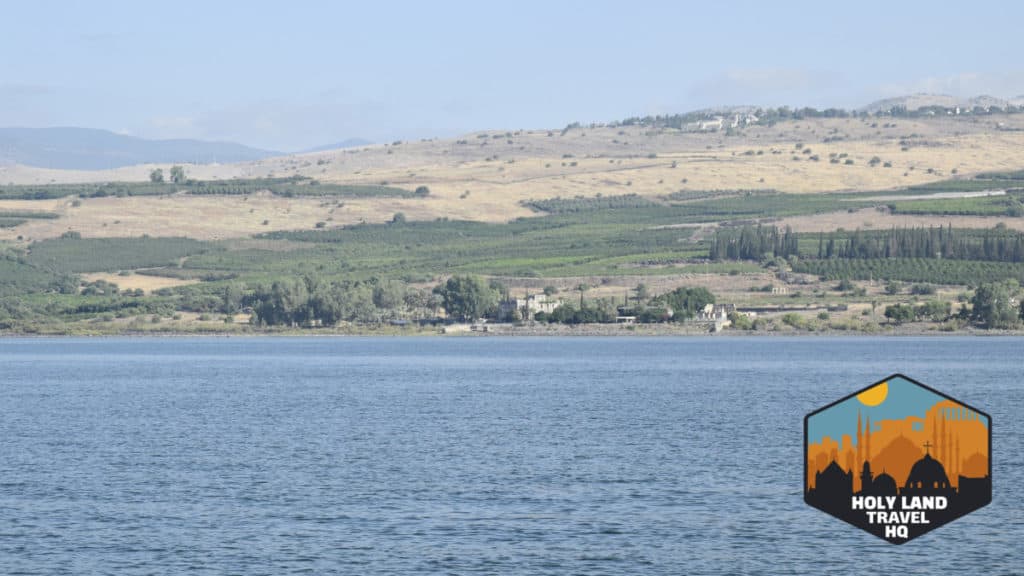
The Sea of Galilee is not a sea, it’s a lake. It’s 64 square miles in area. Which would make it the 80th largest lake in the US if it were in America.
The lake is usually calm and flat. However, it sits in a rift valley, which is a fault line. The valley channels wind and weather fronts. Earthquakes come into play as well. All of this means that the lake can go from calm to tense in an instant.
I’m not going to lie, a boat ride on the Sea of Galilee is really cheesy.
The boats that are used are pretty stable and can fit over 50 people. The crew will pull out a net in the style of the first-century fishing nets. Then they’ll cast it out to demonstrate its use. Then they’ll retrieve it and kick in the engines to get to your drop off point.
When you watch them cast that net, imagine being on a boat with a flat bottom, wide beam and low freeboard. If you aren’t picking up what I’m putting down, I’m referring to a boat that does not have great stability.
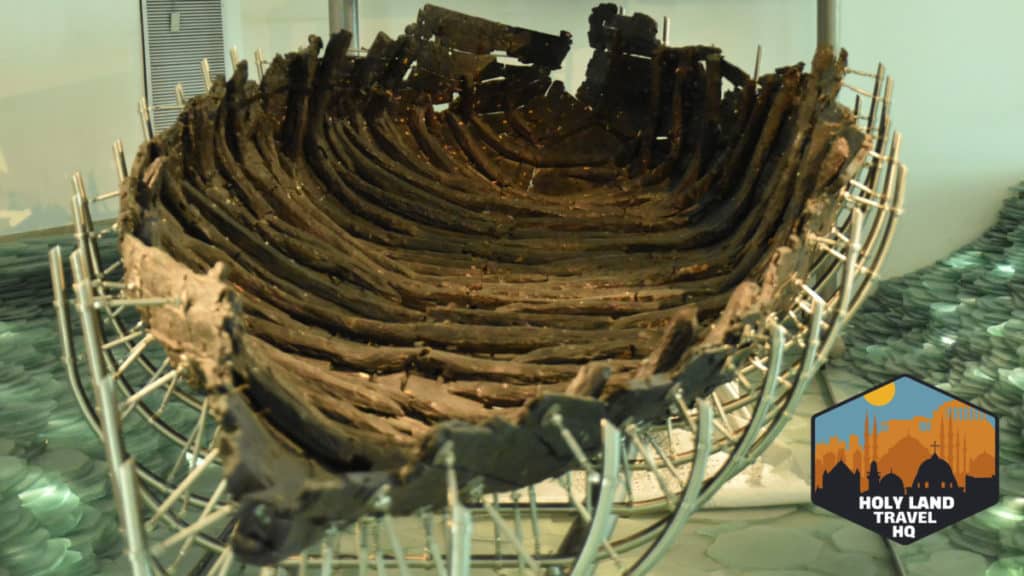
Back in the 1980s, the remains of a boat similar to the first century boats were found encased in the mud of the shoreline. These boats were not big. In order to deal with the shallow shores, they needed shallow drafts.
Towns popped up along the shores of the lake wherever fishing docks thrived. This meant fishermen went wherever there was work. This is a great theological point.
Being a fisher of men means going wherever the need is. And when you cast your net, you cast it wide. Some fish will escape and others will jump back overboard. But the effort is worth it.
5. You can see the complexities of modern and ancient geopolitics sitting on top of each other.
The Israeli-Palestinian conflict is an issue that many want you to see. You see it in the news, and you’ll no doubt get asked questions about it. And you’ll find that a lot of people have opinions about it.
But when you visit Israel, as with any country really, you’ll see a different side. The Holy Land in particular is layer upon layer of religious history. There is a pagan history that predates Jewish history. And then there’s Roman history, Christian history, and Muslim history. And it all conflicted with each other over several millennia.
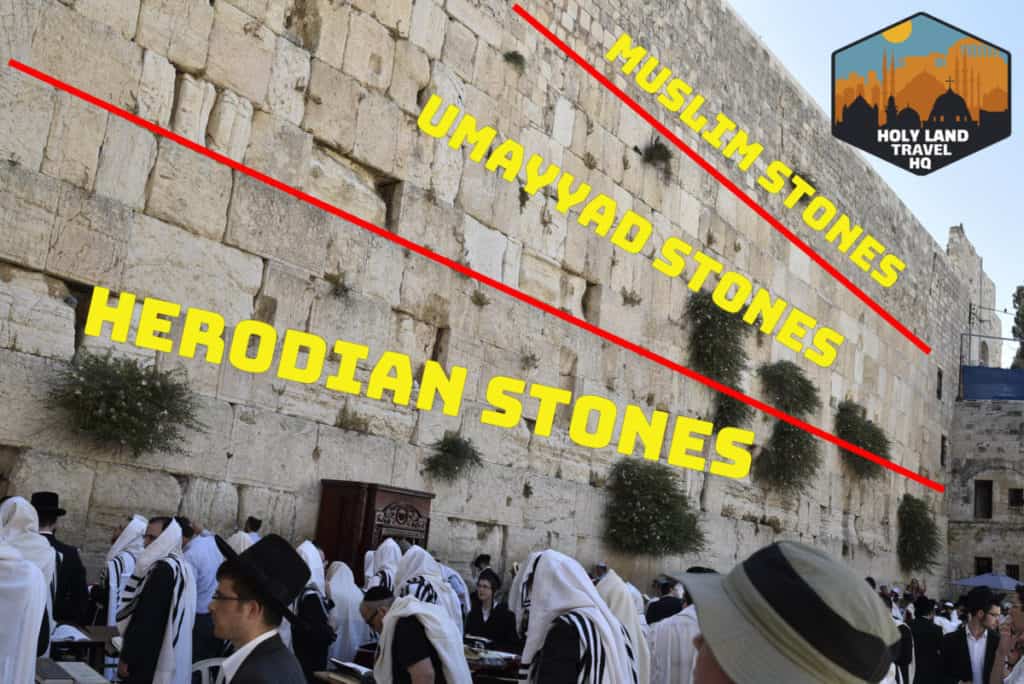
The Holy Land has been a focal point for moving people since the dawn of time. To the east is a vast lifeless desert. And to the west is the sea, which was just as dangerous as the desert to the ancients. The Holy Land sat on the narrow route that connected Asia with Africa.
All of this coming-and-going meant conflict. What you see today is no different then what you would have seen 2,000 years ago. Which was and is a cornucopia of people groups living among each other.
There are Palestinians living and working in non-West Bank Israel. There are Israelis committed to keeping the peace for everyone, not just their own. And there are bad actors running amuck.
You’ll see Muslim shop owners in the Old City market. You’ll see Palestinian Christians in the West Bank. And Hasidic Jews rushing to prayer.
You’ll see the wall around the West Bank. And you’ll see the debris pile that the Muslim Waqf dug out from inside the Temple Mount. A move to clear out any possible remnants that could prove ancient Jewish presence.
Same tom-foolery, same location, same people. Just different dividing lines and issues. You won’t get that on the news.
6. You’ll connect with God and your faith in ways you can’t at home.
When you pray in Israel, it’s actually a local call. Ok, bad joke.
There is no theological basis for finding God in certain places but not others. In the Bible when God’s presence occupied space on Earth, the ground was considered to be holy. But it didn’t remain holy.
God spoke to Moses just as much in Midian as he did in Horeb. And Egypt, the Red Sea, Mount Sinai, and the desert. He’s everywhere.
Throughout the Bible, even in the Old Testament with its Levitical sacrifices, prayer was the primary means to connect with God. In the New Testament, humanity’s relationship with God relied more heavily on this idea. The idea that the church was a people, not a building.
Visiting the Holy Land introduces you to a different way of seeing the stories in the Bible. As you engage with those stories, you will see them with new perspectives.
When you visit the Holy Land, you might not feel close to God the entire trip. In fact, my first time visiting I often wondered why everyone around me felt connected to God but I didn’t. It wasn’t until months later that I started to see something.
Everyone will have a different experience. It’s perfectly normal to head home wondering why your Holy Land tour just felt like a normal vacation.
Eventually, though, something will click. You might be reading the story of Jesus turning over the tables at the temple. Then you suddenly remember walking the Temple Mount and how big it was. This means that a lot of people saw what Jesus did. And that is important.
The more you interact with your experience, the more you will understand God. As well as the story He is writing for humanity and your life.
7. A Holy Land tour is financially doable and worth it.
Travel anywhere in the world requires a financial commitment. Whether it’s a 10-hour drive to Grandma and Grandpa’s place for Christmas, or Europe, or the Holy Land. If you’re pondering a trip to Israel, don’t let finances hold you back.
For some people, airfare can be expensive and it’s hard to know which trips offer the best experiences.
Some people might feel intimidated by the effort. For a breakdown of tour costs, check out my post on the topic right here. In that post, I break down tours by cost per day. The best tours are in the $300-$350 per day range. That includes lodging and in-country transportation.
The bright side is that churches that put together their own trips tend to be a little cheaper. And they often include airfare because they can get group discounts when departing from the same city. Sometimes churches also offer scholarships to help people out.
If you’re struggling to figure out the finances, start by saving small. Put $25, $50 or even $100 into a separate account each month.
There is also the pastor’s dilemma. A lot of pastors fear pushback at the appearance of wealth or pleasures in their personal life. This is a hurdle that looks bigger than it is.
You are a pastor; God has bestowed the responsibility on you to shepherd a group of people for Him. You need to know your craft.
A Holy Land tour might seem like a pleasure cruise, and it can be if you want it to. Or it can be a learning tour. Treat it like a class. Take notes. Ask questions. Ponder information. Think about ways to incorporate your experience into your ministry.
If an athlete goes to spring training, a minister goes to the Holy Land.
8. The Dead Sea is the lowest place on Earth.
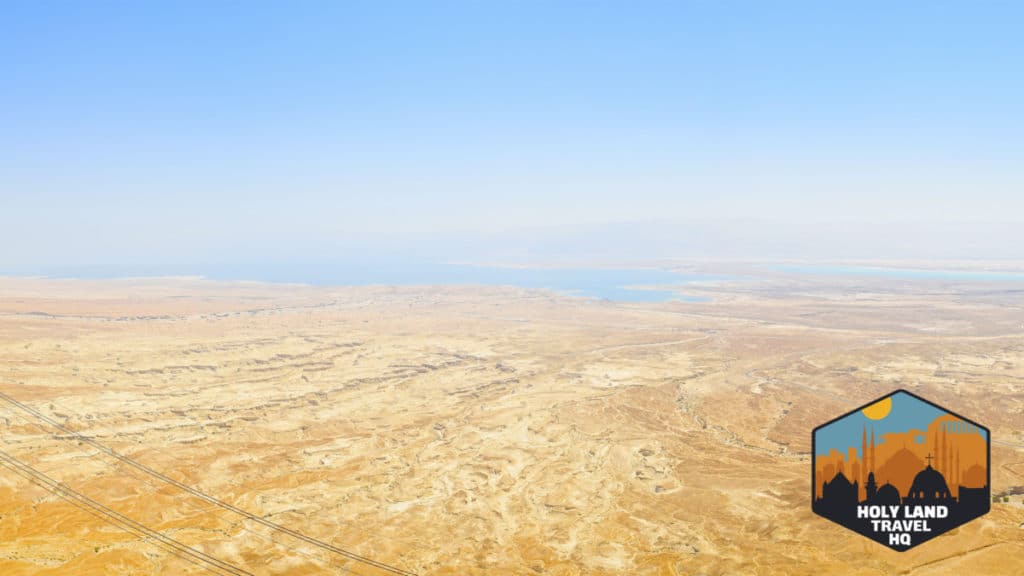
At 1,400 ft below sea level, the surface of the Dead Sea is the lowest place on Earth you can visit. Even if you went diving in the ocean somewhere, you aren’t going down 1,400 ft below the surface. You might get as far as a couple of hundred feet in an underwater rig laboratory, but that’s it.
The Dead Sea is called dead because nothing can live in it. Salinity levels, or salt content, is more than 9 times that of the ocean.
As a result of its salinity, The Dead Sea has a higher density than ocean water. This means that you will float easier in the Dead Sea. A lot easier. In fact, it’s hard to go underwater. You will sit higher when floating as well.
Because the Dead Sea sits so low in the atmosphere, the air is denser too. Meaning there are more air molecules stacked up at the bottom. This makes it hard for radiation from the sun to get through. Though I’d still put my sunscreen on.
For millennia, the Dead Sea has been known for the health benefits of its mud. It has been used to treat psoriasis and other skin ailments. Its also been used for general skin health and beauty treatments.
Scientists have studied the Dead Sea for years. In addition to skin therapy, studies have been done on the effects of the denser air. They’ve seen patients with cystic fibrosis benefit from the higher atmospheric density. Meaning they get more oxygen molecules into their lungs per breath.
One thing to be prepared for though is a slight sting from the high salt content. Some people will make it sound bad, but it’s not. Don’t be afraid to put your suit on and get in the water.
9. Jerusalem is the focal point for all 3 Abrahamic religions.
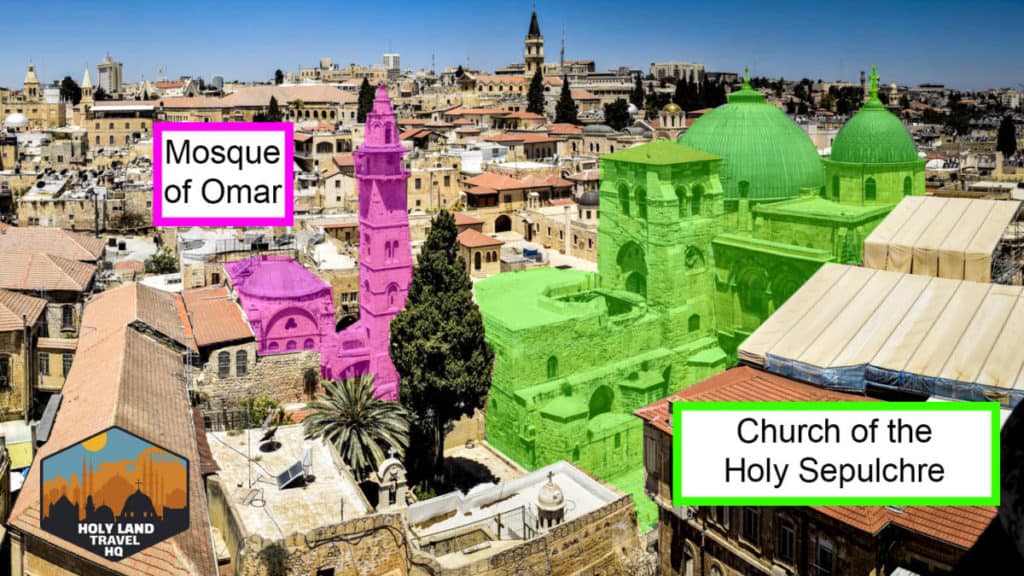
Regardless of Islam’s take on “things,” or Judaism’s denial of Christ, we all trace our roots to Abraham. This is monumental.
There are more than 7 billion people on this planet and a plethora of religious thoughts and religions. Yet there are billions of fingers all pointing at Jerusalem. Something happened there and people know it.
One might say this knowledge is in our DNA. Others might say it’s learned and it needs to be deconstructed. Still, more people might say that it is a big nothing-burger.
Whatever the message is, there is an air of importance around the city of Jerusalem. Whatever happened there was a big deal. There are millions of cities on this planet, but none of them carry this much significance.
The question we need to answer is “why?”
If nothing happened, then why did the city gain so much notoriety?
Why this city? If it’s because it is a gateway between continents, then what about Istanbul? It’s an even bigger gateway. Or Caesarea, or Acco (Acre), which were huge ports and business hubs.
Why are we still talking about it to this day? If Abraham was just a guy and his God was nothing special, why is the conversation still going?
For me, the answer to all these questions rests on the fact that Jerusalem and its monuments point directly to God.
There have been archaeologists and scholars who have tried to disprove the existence of God through research in this city. And they almost always end up finding what the rest of us find. A God-sized footprint.
And like a sasquatch footprint, we’re all looking around to find the culprit. For some, He’s standing right there. For others, they can’t see because they don’t want to.
10. Because it’s old.
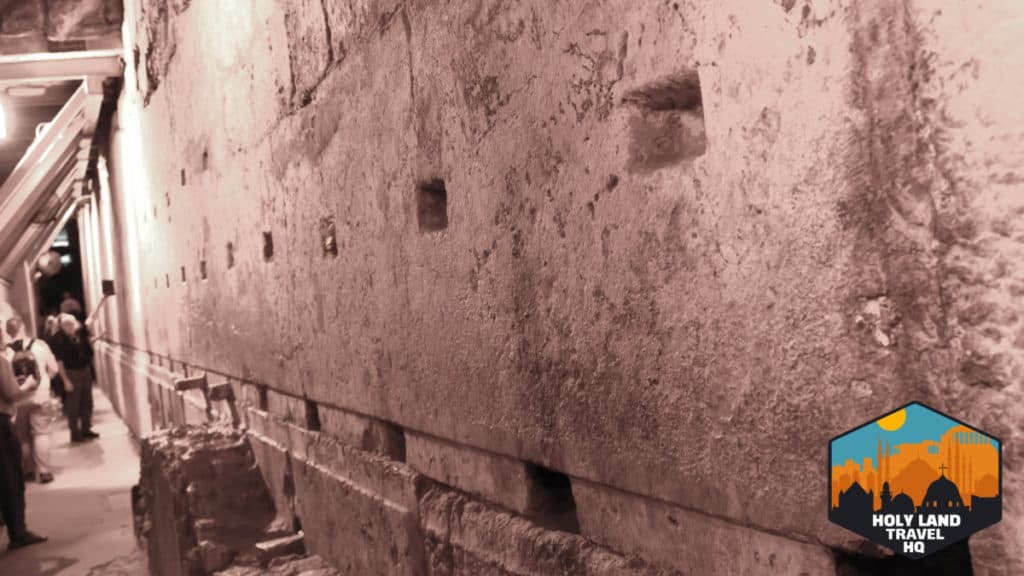
Yes, I know, visiting a destination because it’s old sounds weird. Or naïve. But, I’m serious.
There are few places on earth where we can see ruins of civilizations from thousands of years ago.
Europe is so populated and has been so torn up by war, you can’t go back much farther than the middle ages. Egypt has the pyramids. Iraq has some ruins from Babylon.
There aren’t many places where the old and the new exist in tandem. Much of the Old City Jerusalem is newer. And by newer, I mean 1,000 to 1,500 years old. But there is a lot that is old, such as the Herodian foundation stones for the Temple Mount pictured above. Which you can touch it.
The Herodian stones are distinct by their chamfered dressed edges. The Temple Mount was rebuilt in the first century BC and the foundation is still in use today as a foundation. Archaeologists have also found remnants of a well-preserved sidewalk in the Western Wall underground.
You can literally walk on the same exact pavement that fist century Christians walked on.
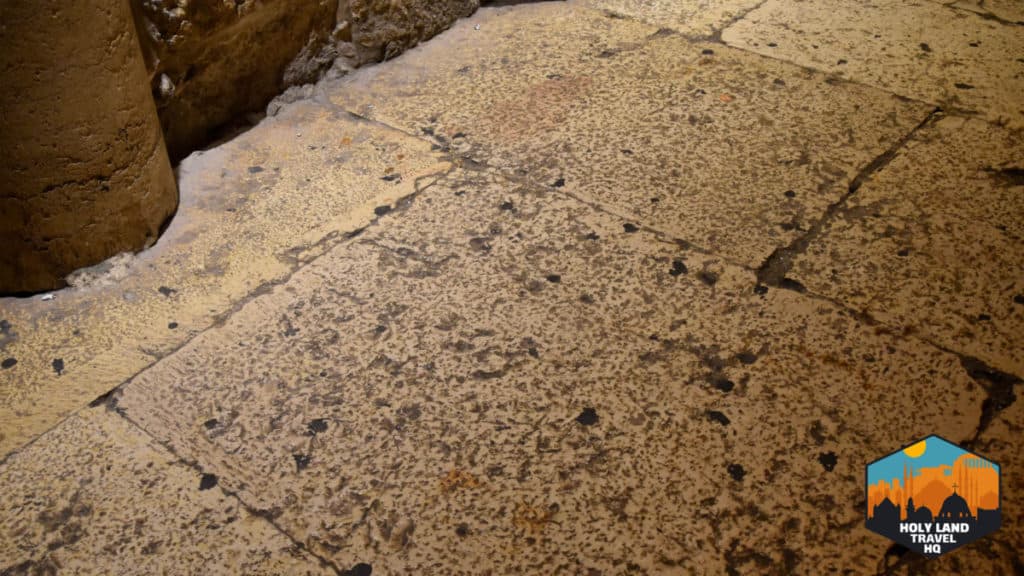
The Church of the Holy Sepulchre is soaked in history. The building you see today is about 1,000 years old. And different parts of the Church go back as far as Jesus’s time.
Needless to say, we don’t have those kinds of interactions with history in America. We can visit the National Archives and maybe see the original constitution behind a billion inches of glass. Or we can go to Philadelphia and see the Liberty Bell.
Either of these things are only a couple hundred years old.
For more on the Western Wall and Church of the Holy Sepulchre, check out the links to my posts on the topics.
11. You can leave a prayer note in the Western Wall.
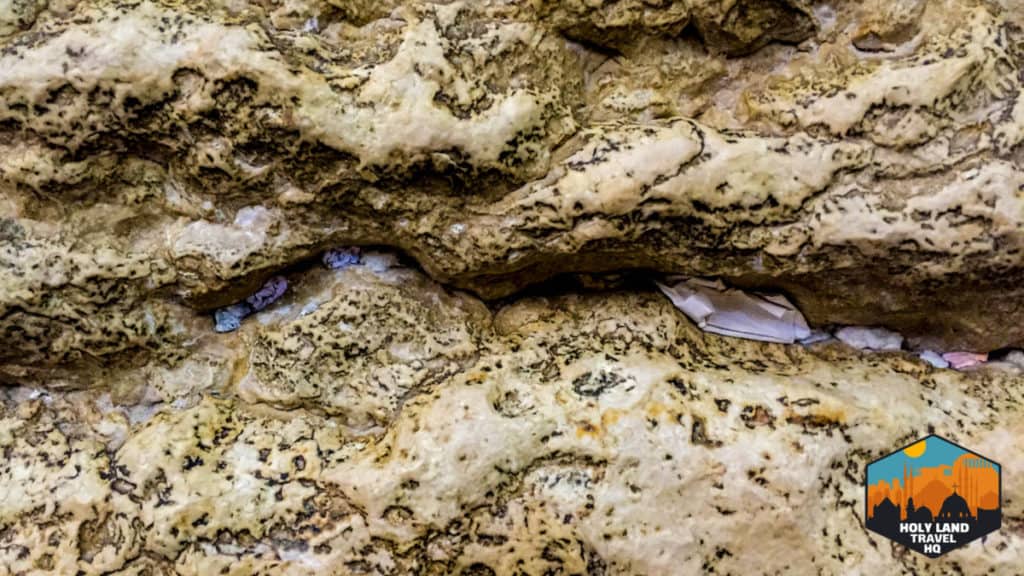
I’m not sure how it started, but there is a tradition of leaving prayer notes between the stones and in the cracks of the Western Wall.
The Western Wall Heritage Foundation cleans the notes out twice a year and buries them on the Mount of Olives.
Granted, you can submit a request on the foundation’s website to have someone place a note for you. But placing one yourself is way better.
The Western Wall is considered an active outdoor synagogue. This means men must wear a hat, and women must cover their shoulders and knees. People pray at the wall at all hours of the day and night.
For Jews, the wall is the closest they can get to the location of the Hebrew Temple. As a Christian, I’m don’t buy into it as a way to get physically close to God.
Praying at the Western Wall will not get you any brownie points with God or special consideration for your prayer. However, I think there is something special about praying at or near the location that many of the people in the Bible did.
David built an altar on Mount Moriah. His son, Solomon, built a temple. That temple was destroyed and another built. Jesus visited the Herodian temple as a child and again before His crucifixion.
How cool is it that we can worship and pray just like they did thousands of years ago? As if we are just carrying on the tradition.


